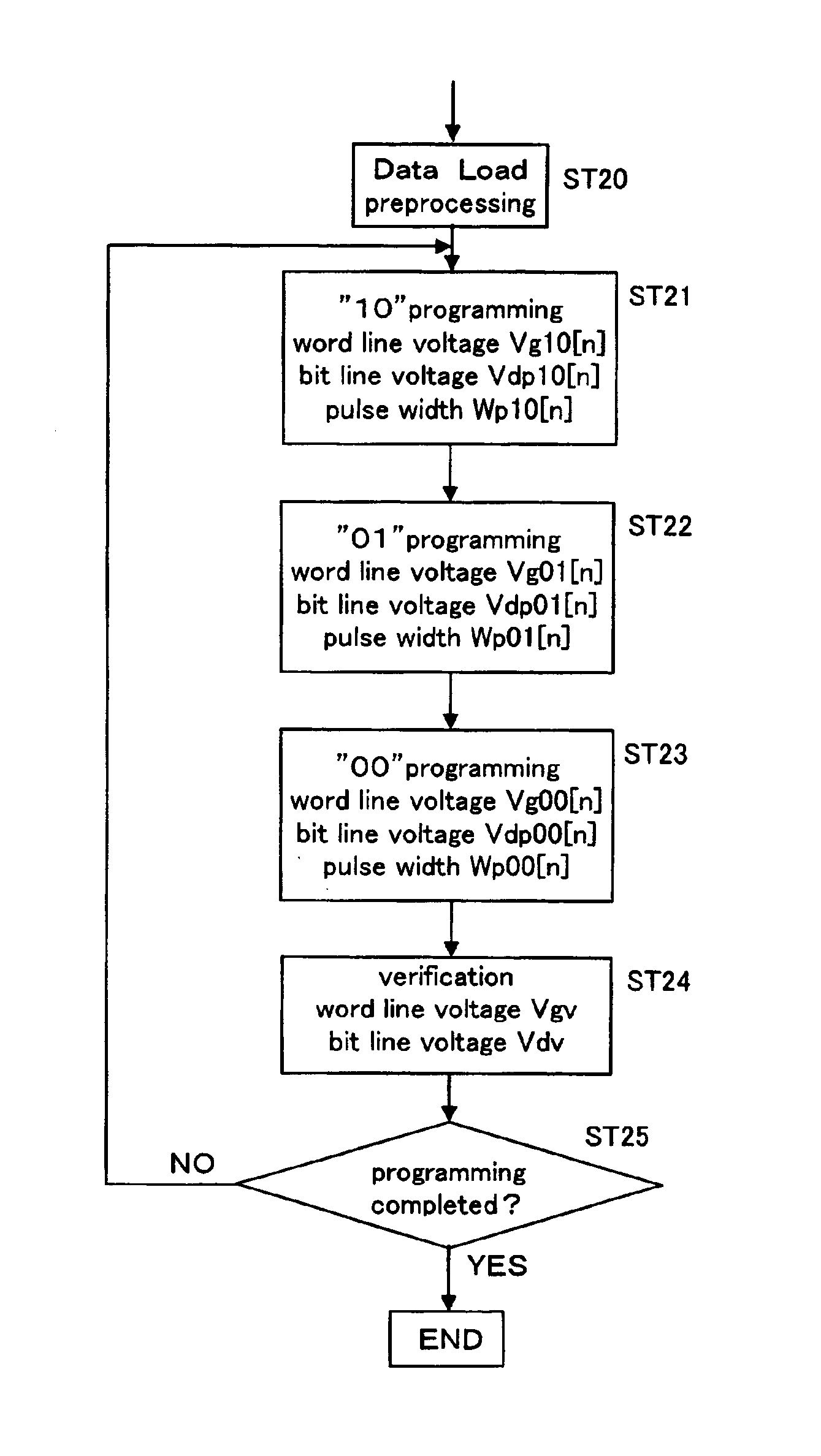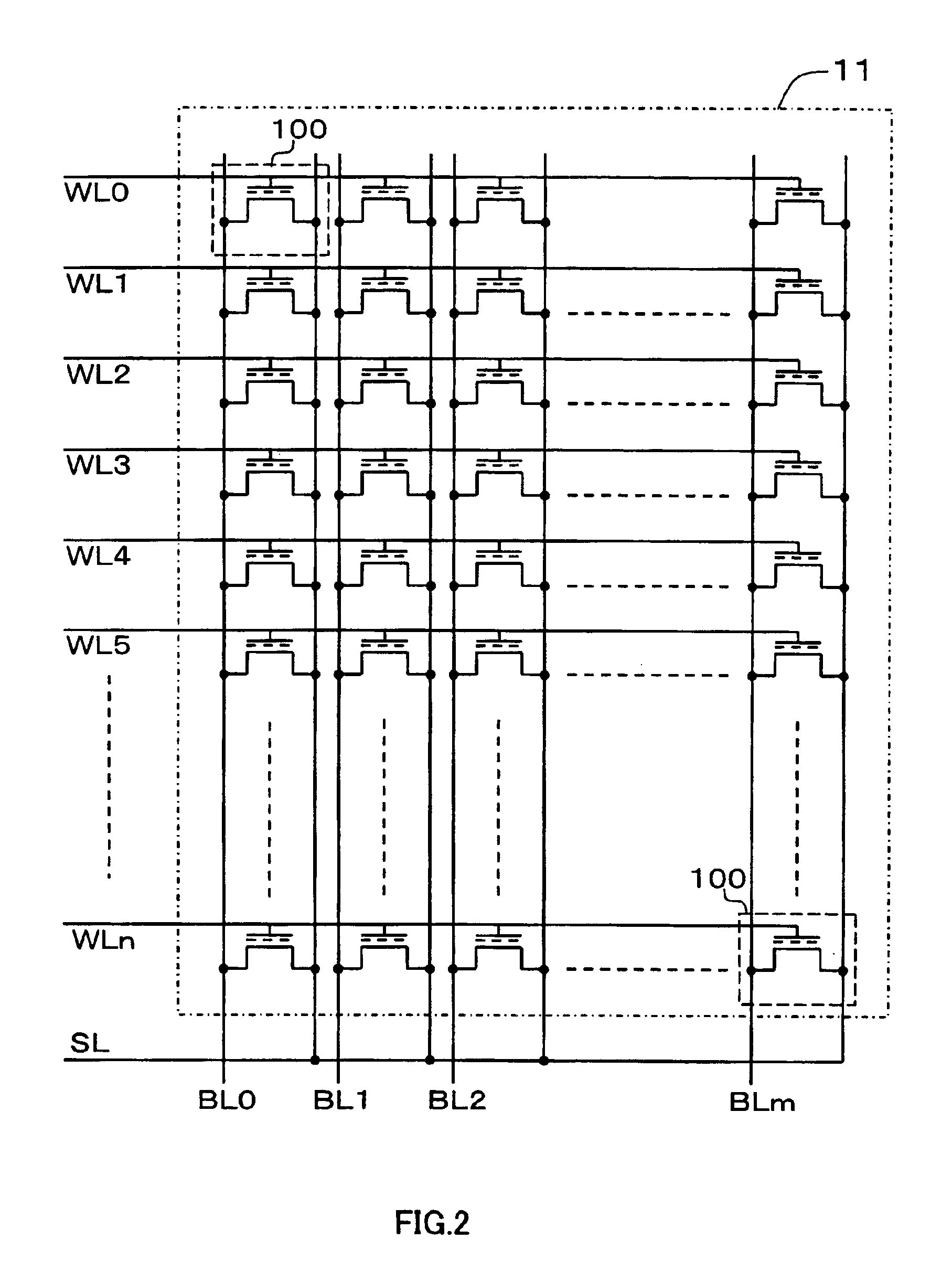Programming method of nonvolatile semiconductor memory device
a nonvolatile semiconductor and memory device technology, applied in static storage, digital storage, instruments, etc., can solve the problems of increasing the current peak at the programming time, especially the current consumption at the programming tim
- Summary
- Abstract
- Description
- Claims
- Application Information
AI Technical Summary
Benefits of technology
Problems solved by technology
Method used
Image
Examples
first embodiment
[0075]FIG. 1 is a block structure diagram showing a functional schematic structure of the embodiment of an inventive device 10. In the meantime, descriptions about the details of peripheral circuits such as input circuits for plural address input signals (ADD in the same figure), plural data input signals (DI in the same figure), plural control signals (CTRL in the same figure) and the like, output circuit for plural data output signals (DO in the same figure), decoder circuit for address input signals and the like are omitted because they are the same as the nonvolatile semiconductor memory device like a well known flash memory. FIG. 1 depicts mainly a circuit portion relating to a programming operation of a main memory array 11 (hereinafter referred to as memory array 11) of the inventive device 10.
[0076]As shown in FIG. 1, the inventive device 10 comprises a memory array 11, a reference memory array 12, a word line voltage supply circuit 13 for supplying a word line voltage to th...
second embodiment
[0100]The case where there exist plural programming target memory cells on the same word line and their object memory states (threshold voltages) are different has been stated a little in the description of the first embodiment. This case will be described in detail with reference to FIG. 3. In a following description, assume that a set of memory cells to be programmed to the memory state “10” is A0, a set of memory cells to be programmed to the memory state “01” is B0 and a set of memory cells to be programmed to the memory state “00” is C0. In the meantime, the method according to the second embodiment of the present invention is executed with the inventive device 10 shown in FIGS. 1, 2 like the first embodiment.
[0101]From the initial state (ST20), first, the word line voltage is charged up to Vg10[0] and a bit line voltage Vdp10[0] is applied to all the memory cells included in A0, B0, C0 with a pulse width Wp10[0] so as to raise the threshold voltages of all the programming targ...
third embodiment
[0106]Next, an embodiment for the case where there exist plural programming target memory cells on the same word line and their object memory states (threshold voltages) are different will be described with reference to a flow chart of FIG. 8. Here, like the second embodiment, it is assumed that a set of the memory cells to be programmed to the memory state “10” is A0, a set of the memory cells to be programmed to the memory state “01” is B0 and a set of the memory cells to be programmed to the memory state “00” is C0. Because in the programming sequence shown in FIG. 8, a flow of steps ST30 to ST35 is equal to the steps ST20 to ST25 (see FIG. 3) of the second embodiment; therefore, its description will not be given here.
[0107]For sets A1, B1, C1 of programming target memory cells whose verifications do not pass in step ST35 of the first time, the word line voltage Vg10[1] (=Vg10[0]+ΔVg10[1]) (ΔVg10[1] is a larger voltage than 0 V) is set up again (ST36), a word line voltage Vg10[1]...
PUM
 Login to View More
Login to View More Abstract
Description
Claims
Application Information
 Login to View More
Login to View More - R&D
- Intellectual Property
- Life Sciences
- Materials
- Tech Scout
- Unparalleled Data Quality
- Higher Quality Content
- 60% Fewer Hallucinations
Browse by: Latest US Patents, China's latest patents, Technical Efficacy Thesaurus, Application Domain, Technology Topic, Popular Technical Reports.
© 2025 PatSnap. All rights reserved.Legal|Privacy policy|Modern Slavery Act Transparency Statement|Sitemap|About US| Contact US: help@patsnap.com



